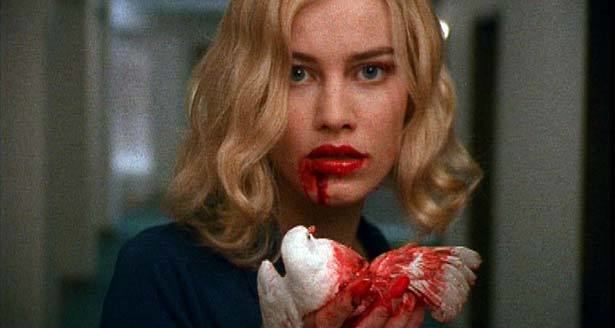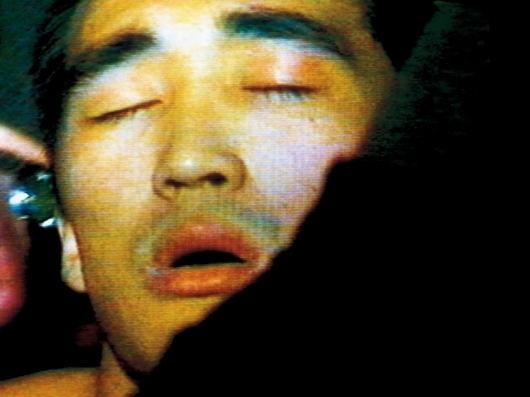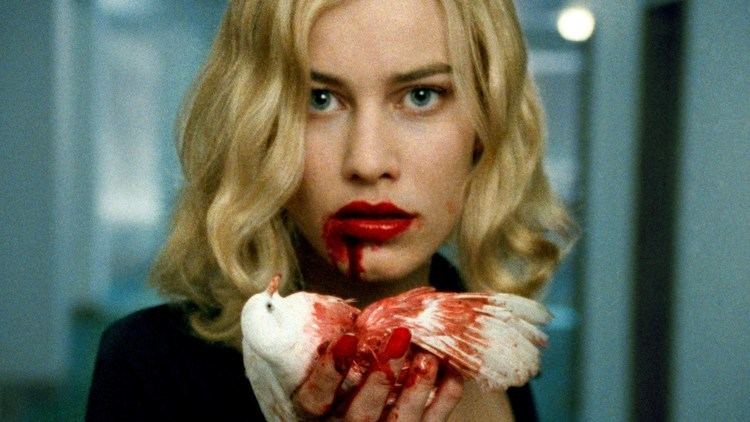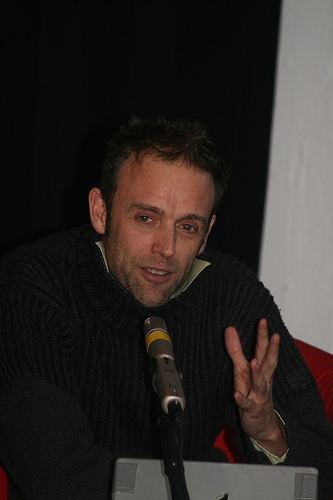Nationality Belgian Name Johan Grimonprez | Role Multimedia artist | |
 | ||
Education The German Academic Exchange Service (DAAD) Berlin (1997)Jan van Eyck Academy, New York (Post Graduate FA, 1995)Whitney Museum Independent Study Program, New York (1993)School of Visual Arts, New York (MFA Film & Mixed Media, 1992)School of Arts, KASK, Ghent (BA Photography & Mixed Media, 1986) Occupation Filmmaker, artist, curator Awards Sundance Film Institute Production Grant (2011)Black Pearl Award: Best New Documentary Director MEIFF (Abu Dhabi, 2009)First Prize European Media Award (Osnabruck, 2006)First Prize International Media Award (SWR/ZKM Karlsruhe 2005)Golden Spire: Best Director IFF San Francisco (1998)Grand Prix de la Ville de Geneve, Biennale de Video (Saint-Gervais Geneve, 1993) Movies Dial H-I-S-T-O-R-Y, Double Take, Looking For Alfred, ...Because Superglue Is Forever! Books Looking for Alfred, It's a poor sort of memory that only works backwards Similar People Tom McCarthy, Delfine Bafort, Michal Dabal, George W Bush, Zale Kessler | ||
Interview with johan grimonprez
Johan Grimonprez (born 1962) is a Belgian multimedia artist, filmmaker, and curator. He is most known for his films Dial H-I-S-T-O-R-Y and Double Take. As of 2014, Grimonprez's upcoming projects include the feature films How to Rewind Your Dog and Shadow World: Inside the Global Arms Trade, based on the book by Andrew Feinstein.
Contents
- Interview with johan grimonprez
- Johan grimonprez dial h i s t o r y part01
- Personal life
- Themes
- Shadow World
- Double Take
- Dial H I S T O R Y
- Kobarweng Or Where is Your Helicopter
- Curated programs
- Beware In Playing the Phantom You Become One
- Maybe the Sky is Really Green and Were Just Colourblind On Zapping Close Encounters and the Commercial Break
- Art
- Books
- Published essays
- Interviews selected
- Feature films
- Shorts
- Television
- Multimedia
- Vlogs
- Awards
- References

Johan grimonprez dial h i s t o r y part01
Personal life

Grimonprez was born in 1962 in Roeselare, Belgium. After studying cultural anthropology, he went on to complete his studies in photography and mixed media at Royal Academy of Fine Arts in Ghent. Grimonprez earned an MFA in Video & Mixed Media at the School of Visual Arts in New York. In 1993, Grimonprez was admitted to the Whitney Museum Independent Study Program and later attended the Jan van Eyck Academy in Maastricht, Netherlands. In 1993, Grimonprez worked on the series Besmette Stad for the program Ziggurat on Belgian television.
Themes

His films are characterised by a criticism of contemporary media manipulation, described as: "an attempt to make sense of the wreckage wrought by history." This films "speak to the need to see history at a distance, but at the same time to speak from inside it". Other themes include the relationship between the individual and the mainstream image, the notion of zapping as "an extreme form of poetry", and the questioning of our consensus reality, which Grimonprez defines as: "a reality that is entangled with the stories we tell ourselves in the worldview we agree on sharing." Grimonprez claims that "Hollywood seems to be running ahead of reality. The world is so awash in images that we related to 9/11 through images we had already projected out into the world. In a sense, fiction came back to haunt us as reality. A perpetual distraction, this illusion of abundance staged by techno-magic hid the ugly face of an info-dystopia. Images of Abu Ghraib, 9/11, swine flu, the BP Gulf oil spill and the economic crisis composed our new contemporary sublime." Amongst Grimonprez’s influences are Walter Benjamin, Jorge Luis Borges, and Don DeLillo.
Shadow World
Shadow World is a documentary about the international weapons trade. The film is based on Andrew Feinstein's book "The Shadow World: Inside the Global Arms Trade" (2011). Feinstein's book exposes the "parallel world of money, corruption, deceit and death" behind the trade in arms. Key interviews include: Jeremy Scahill, Chris Hedges, Michael Hardt, Noam Chomsky among others. Grimonprez claims that "the contemporary condition of what it is to be human calls into question the relevance of politics and reality, one that has collapsed under the weight of an information overload and mass deception." To him the present political debate "has schrunk into mere fear management and paranoia suddenly seems the only sensible state of being, where it is easier to ponder the end of the world than to imagine viable political alternatives. "Shying away from getting stuck into merely critiquing social evil, I began exploring alternatives. It's indeed important to say what we don't want, but more crucial is to point at what we actually do want." According to Grimonprez, the film not only exposes how corruption drives the global arms trade, while it often sets the stage for war, it hopes to offer also alternatives to the paradigm of greed, celebrated by social darwinism.
Double Take
Released in 2009, Double Take combines documentary and fictional elements. The plot, written by British novelist Tom McCarthy, centres on Alfred Hitchcock and a fictitious meeting Hitchcock has with an older version of himself during the Cold War. Using the allegory of a sky-borne threat, Double Take charts the rise of the television in the domestic setting and with it, the ensuing commodification of fear. The five Folgers commercials for instant coffee that play throughout Double Take are standing for the commercial break of the television format as well as for the exploration of the theme that fear and murder lurks in the domestic setting. Inspired by the Jorge Luis Borges short story "25th August, 1983", it plays on the Hitchcockian/Borgesian aphorism that "if you should meet your double, you should kill him... Or he will kill you...” This encounter with the double or the mirroring of Hitchcock versus Hitchcock (as Hitchcock frequently doubled himself as the storyteller in his films through his cameos), sketches out the theme of the doppelgänger- the parody of the original. This mirrors the plot of rivalry between cinema (Hitchcock the filmmaker), its television double (Hitchcock the television-maker) and the younger YouTube Hitchcock. This mistaken identity is described by Grimonprez as "the uncanny feeling that in a situation, something, or someone looks exactly the same as another, but somehow is not, and hence is totally displaced. It creates an unease and a sense of anxiety announcing the impending disaster, but precisely because of this, reveals a glimpse of the sublime."
Dial H-I-S-T-O-R-Y
Dial H-I-S-T-O-R-Y is an essay film that traces the history of airplane hijackings as portrayed in mainstream television. Set against a backdrop of a chronology of airline hijackings, beginning with the first documented airplane hijacking in 1931, which was immediately inscribed into the political arena from the get-go. Dial H-I-S-T-O-R-Y illustrates how, as hijackings got progressively more television coverage, they became more and more deadly. The nature of live television allowed for a minute by minute update of the hijack as the situation unravelled; blurring the line between entertainment and tragedy, For terrorists seeking to inscribe their struggle in history, the hijack devoid of the mediatized image of itself lost all of its communicative power. With the airplane always on the move between countries and borders as if in state of nowhere, the hijack came to symbolize the transgression across a violent border towards a political utopia. "This study in pre-Sept. 11 terrorism" is interspersed with passages from Don DeLillo's novels Mao II and White Noise, "providing a literary and philosophic anchor to the film." Questioning the role of the writer in an image saturated society, Dial H-I-S-T-O-R-Y's narrative is based on an imagined dialogue between a terrorist and a novelist where the writer contends that the terrorist has hijacked his role within society: "there's a curious knot that binds novelists and terrorists. Years ago I used to think it was possible for a novelist to alter the inner life of the culture. Now bomb-makers and gunmen have taken that territory." As the plot progresses, it becomes clear that with the increasing media coverage of terrorist hijacks, this power of producing an inward societal shock has been wrestled from the writer by the terrorist. They are 'playing a zero-sum game' where “what the terrorists gain, novelists lose!” By the 1990s, the individual hijackers apparently are no more, "replaced on our TV screens by stories of state-sponsored suitcase bombs". By now, the media is increasingly involved as a key player; "the images of the individual is substituted by a flow of crowds; hijacking is replaced by anonymous suitcase bombs. [...] Since the eighties, the Reagan Administration started to accommodate the terrorist spectacle to veil its own dirty game in El Salvador, Guatemala and Nicaragua. Terrorism became merely a superficial game played through the media". In this sense, the deeper underlying theme is that the hijackers' hijack was becoming itself hijacked by news media corporations. The piece premiered in 1997 at the Musée National d'Art Moderne in Paris and was later screened at documenta X in Kassel.
"Kobarweng Or Where is Your Helicopter?"
The short documentary "Kobarweng or Where is Your Helicopter?" (1992) deals with the history of a remote village in the highlands of New Guinea. The videotape assembles archival footage and oral histories depicting the first encounter between the Irian Jaya people and the scientific crew, including anthropologists, of the Dutch Star Mountains Expedition. The confrontation with the crew and their helictopter caused a shock that threw the worldview of the villagers upside down. The event even entered their Sibil-tongue language; literally translated, weng means language, whilst kobar airplane. "Kobarweng's" title is an ironic reference to a question first posed to Grimonprez by a local man named Kaiang Tapor, who, upon Grimonprez's arrival in the village of Pepera after a three-day hike, asked him where his helicopter was. The footage in the film is traversed by a running band of script, reporting observations and remarks culled from anthropologists' interviews, eye-witness reports, and the reminiscences of those highlanders who recall those moments of 'first contact' between the white intruders (missionaries, prospectors, anthropologists, adventurers) and the local inhabitants: "We never tell everything, we always keep something for the next anthropologist" they are candid enough to admit to Margaret Mead, while another wit remarks: "We called the whites 'people of soap', but their shit smelled the same as ours." Switching the roles of observer and observed, the relation implied in the anthropological representation is reversed: the desire of the observing anthropologist itself becomes “other”, “exotic”, an object of curiosity destabilised by the villager’s questions. According to Grimonprez:
Kobarweng critically considers the myth of objectivity, the pretence of an epistemic and scientific detachment maintained not just by the anthropologist, but throughout the discourse of western science, where the observer finds himself caught in an alienated position of transcendence over his/her subject."
In 1994, Grimonprez showcased a five-channel installation, It Will Be All Right If You Come Again, Only Next Time Don't Bring Any Gear, Except a Tea Kettle..., which expanded upon the themes of "Kobarweng". The encounter between the different groups in 1939 up to the current problems caused by neocolonialism: The province is occupied by the Indonesian military and according to a Yale University Law School report "there can be little doubt that the Indonesian government has engaged in a systematic pattern of acts that has resulted in harm to a substantial part of the indigenous population of West Papua." Amnesty International found that there were no effective means for people of the public could complain against the police acting in violation of international law and standards.
Curated programs
All curated programs, in the form of a video lounge, could be seen as a media-jamming tool at the hand of an extensive collection of clips, that can be envisioned both as the joyful affirmation of a global disengagement of corporations abducting our very essence, patenting and privatizing for profit, alienating our food & bodies by creating a genetically modified variant and the catalyst of debate. According to Grimonprez, the participatory elements would be sometimes as simple as a hot cup of coffee. "We would never install our video-library without having cookies, the smell of coffee and the remote control present. These elements already induce a platform of conviviality, an atmosphere for chatting. You are invited to pick up the remote to zap through your own choice of videotapes, in a way to be your own curator."
Beware! In Playing the Phantom, You Become One
Beware! In Playing the Phantom, You Become One is a videolounge based on the history of television, created in collaboration with Herman Asselberghs. In the work, Grimonprez questioned the image of the spectator as a passive consumer and seeks to detect the impact of images on our feelings, our knowledge and our memory. In his opinion, the homogeneity of what the media have to offer presents a creative context in which images can consciously be read the wrong way. The boring uniformity of mainstream TV can never impose uniformity in its perception.
Maybe the Sky is Really Green, and We’re Just Colourblind: On Zapping, Close Encounters and the Commercial Break
This ongoing curated video-library/vlogging installation is a project on the history of the remote control and zapping in relation to the commercial break and how zapping and channel surfing were installed as a new way to relate to the world in the 80s. While Walter Benjamin and Sergei Eisenstein defined montage as a revolutionary tool for social analyisis, MTV and CNN have surpassed this. Grimonprez said: "I saw what CNN did with war footage and then all these commercials spliced in between. I thought of the zapping as the ultimate form of poetry. It’s a visual poem." The project continues as, according to Grimonprez, zapping became useless after 9/11 as all channels were beaming the very same images of the collapsing "Towering Infernos", over and over again. No longer did the media have to keep up with reality, but rather reality was now keeping up with the media. No longer happy innocent consumers of a bygone TV era, we are said to have become both avid consumers of fear and the protagonists of an increasing ubiquity of systems of surveillance.
Art
Grimonprez made his introduction to the international scene at the Documenta X in Kassel with his Dial H-I-S-T-O-R-Y in 1997. Ten years later, the first retroperspective Johan Grimonprez - Retrospective 1992–2007 took place in the Pinakothek der Moderne in München, 2007. It’s a Poor Sort of Memory that Only Works Backwards followed as the first large-scale retroperspective of Grimonprez in his native country; Belgium, in the Stedelijk Museum voor Actuele Kunst (SMAK) in Ghent, 2011–2012. ArtForum described the exhibition as "an unfamiliar archive [...] from the perception of fragments to the awareness of a common mentality, from the multiplicity of words to the emergence of a discourse". Several artists, among Roy Villevoy, Jan Dietvorst and Adam Curtis were invited to contribute to this exhibition. A prominent aspect in Grimonprez's work is the sky: "a canvas on which man has always projected his mystical aspirations, his political and economic struggles, and his poetic imaginings. They abstract spaces into which the very real histories of contemporary societies are woven". According to ArtForum, the critical dimension of Grimonprez's work follows close behind the "aesthetic of disaster and terror and the virtues of channel surfing in order to plunge the viewer into a state of genuine fascination". Using repetition and delay, Grimonprez works towards a second glance; a double take - just like his feature-length film Double Take (2009), and "the state of confusion in which we are kept by the media machine". ArtForum states that Grimonprez "does not harangue us with denunciations but rather suggests that we reconsider the short circuits of this machine, of which we briefly catch glimpses". It’s a Poor Sort of Memory that Only Works Backwards also exhibited at the Blaffer Art Museum in Houston, 2011 and the retrospective Johan Grimonprez exhibited in The Fruitmarket Gallery in Edinburgh, 2010.
Furthermore, Johan Grimonpez is presented by the Sean Kelly Gallery in New York and the Galerie Kamel Mennour in Paris with for example Are You Ready for TV? in the Museu d'Art Contemporani de Barcelona in 2010; We never tell everything, we always keep something for the next anthropologist in the Yvon Lambert Gallery New York in 2004 and the Deitch Projects in New York, 2000.
